How to use Data Miner to extract data from websites
If you're copying and pasting everything from web pages and putting them into a spreadsheet manually, you won't know what data scraping is (or web scraping). Maybe you know what they are but don't really care about the idea of learning to code just to save yourself a few hours of clicks.
Either way, there are plenty of code scraping tools that don't need code to help you in such situations, and the Chrome Data Miner extension is one of the most intuitive options. If you're lucky, the task you are performing will be included in the recipe book section of this tool. At that time, you do not even have to go through the steps to build your own formula.
Instructions for using Data Miner to extract data from the web
- How does Data Miner work?
- 1. Set up Data Miner
- 2. Load data
- 3. Check the recipe
- 4. Page type
- 5. Create a row
- 6. Divide the data into columns
- 7. Tell the Data Miner how to get to the next page
- 8. Tell the Data Miner where to click or scroll to load the data
- 9. Save and run the formula
- If there is a problem, is there an easier way?
How does Data Miner work?
The Data Miner tool helps you remove data from webpages and import them into beautifully formatted Excel / CSV files by looking through the text of the pages you have loaded. That means you will at least need to be comfortable working with HTML to recognize some patterns, but not too broad knowledge. Advanced HTML and / or JavaScript skills will definitely help some tasks, but are not necessary for most things. You should also have at least basic spreadsheet skills so you can make sure your output is neat and organized.
1. Set up Data Miner
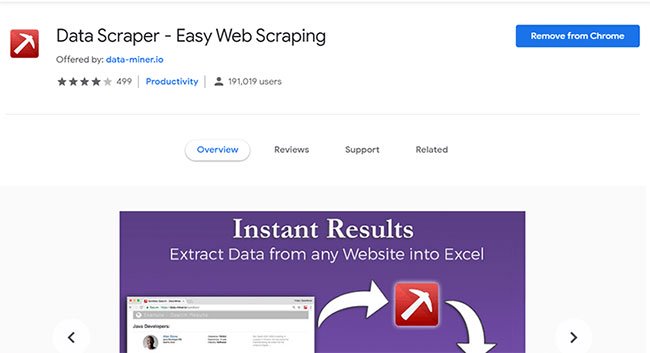
Use Chrome or another Chromium browser, then install the extension. The icon of the extension will appear on the toolbar. Clicking on it will take you to a page where you can set up an account. The free version gives you 500 scrapes (data extraction) per month, which is probably sufficient, unless this is what you do every day.
2. Load data

First, navigate to the page you want to extract the data from. If you have a lot of data pages or some data hidden behind buttons, that's fine - there are ways to deal with this situation. For now, you'll only need a representative form so the program knows what to look for.
3. Check the recipe
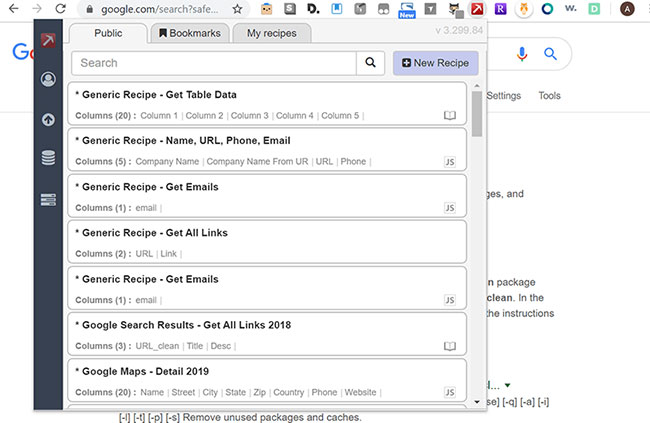
Next, open the Data Miner and check the 'Public' tab for available formulas. If you are on a popular website, someone else may have created the process to retrieve the data you are looking for. This will save you a lot of time. For example, websites like Google, Amazon and Twitter have lots of formulas available to help you instantly download links, prices, text and other data. You can check the formulas by clicking the Run button to see a preview of the worksheet created by the Data Miner. You can also adjust existing formulas to suit your needs, by clicking the 'Edit' button .
4. Page type
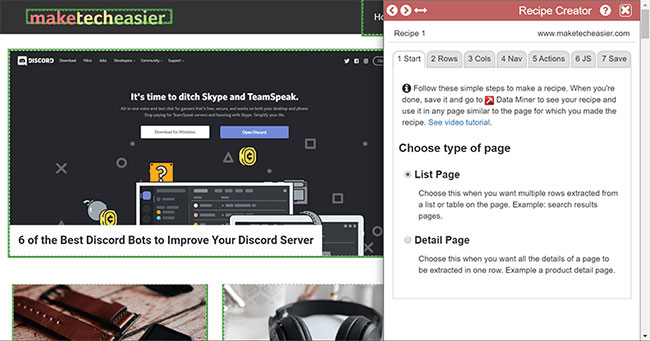
If none of the formulas is right for you, that's okay, you can create your own. Just click the 'New Recipe' button to get started.
Your first choice will be either 'List Page' or 'Detail Page' .
- Select 'ListPage' if you are trying to retrieve multiple rows of data on a page. For example, you might want to download the link and page title of each search result or get the date and content of the post in the feed. This is probably the most common type and will be used as a model in this article. (The steps for the 'Detail Page' are basically the same.)
- Select 'Detail Page' if you have a lot of different information about something on the page - for example, the product page, where you need to get its price, description, link and rating, then put it all in. a row.
5. Create a row
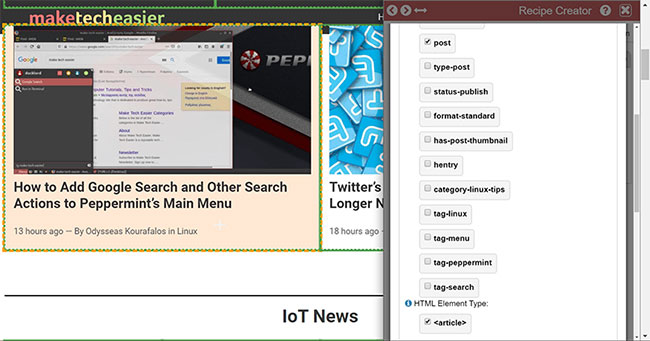
Click the 'Find' button and move the mouse until the yellow check box includes all the data you need for the final worksheet entry. For example, if you download the search results, you will need to highlight an area large enough to include the title, URL and description, each of which can be placed in separate columns in the next step. To make a selection, press the Shift key. Don't worry if you accidentally let go. Data Miner saves all processes even when you navigate away from the page.
You will then want to select at least one of the boxes under 'Element's Classes' or 'HTMLElementType' . Ideally, you should see the selection cover all elements on the page that are of the same type as the one you selected.
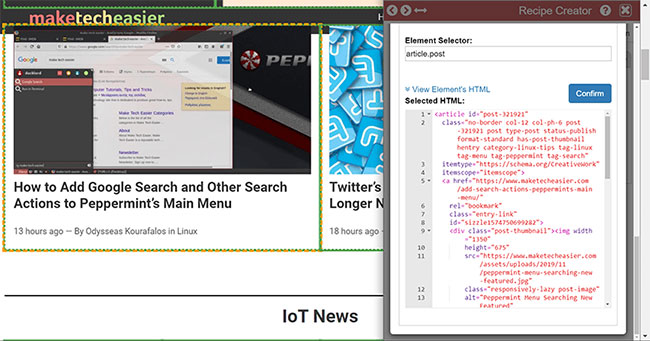
If you find that the selector doesn't include everything you need, try selecting just one of the elements and clicking 'SelectParent' . This will make the box bigger and be able to capture everything you need. If not, you may need to dig into the HTML a bit and identify the classes and element types you need. When in doubt, click 'Select Parent' until the box is as big as possible without including multiple list entries, as this will give you more flexibility when selecting columns.
Data Miner gives you the 'View Element's HTML' option at the bottom and also allows you to enter custom selectors. If you want to get all the links on a page with class 'product' , you can simply enter a.product . This is where some basic HTML / CSS knowledge will really help.
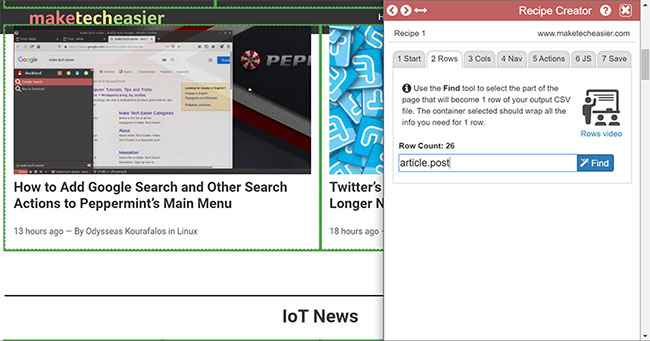
When you return to the main row menu, you'll see the 'Row Count' option with the number of items your formula will create in a spreadsheet. If it does not include everything, you will need to double check your item selection.
6. Divide the data into columns
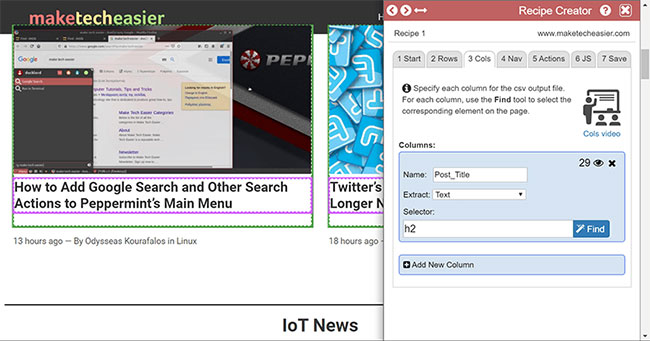
Once you've selected all the data for your rows, it's time to make everything look good by dividing it into different types of columns. Each selection made here must be a subsection of the box you selected for your row.

To create a column, just enter a name for it and use the Find button to select what you want to extract, just as you did for the rows. The most common data likely will be text, URL or image URL. Getting the URL by hovering over the text links can be a bit tricky. You may have to click on 'Select Parent' until you reach the level in which Element Type is, which is the HTML tag for the link.
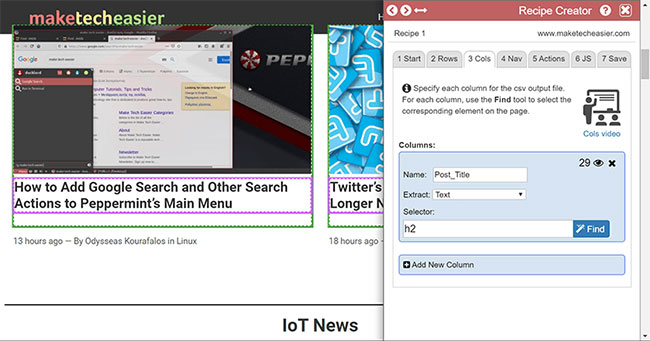
To ensure you have the right type of data in your column, simply click the eye icon to the right of each column name, next to the number indicating how many columns you have selected. This will show you a preview of each row for that column. If something goes wrong, go back to correct the tags and categories you have chosen to identify the rows. Don't be afraid to open the HTML viewer and check out the patterns related to the data you are trying to get.
7. Tell the Data Miner how to get to the next page
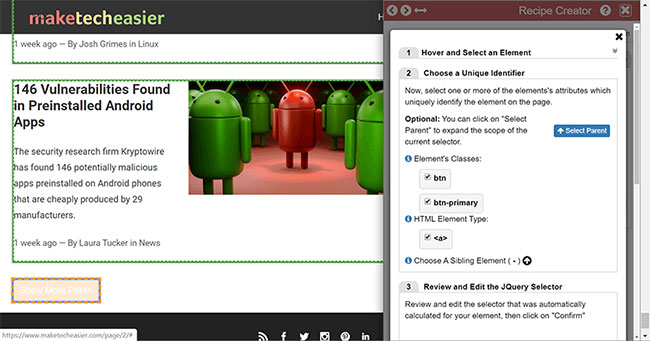
If you have multiple data pages to extract, you probably don't want to click through each page and run your formula again. To solve that problem, just tell the Data Miner where to find the navigation button it needs to click to go to the next page. Be careful not to tell it to click on something like 'Page 2' , because then it will only go to Page 2 . Again, make sure you are selecting an element and use the Test Navigation button to make sure it works.
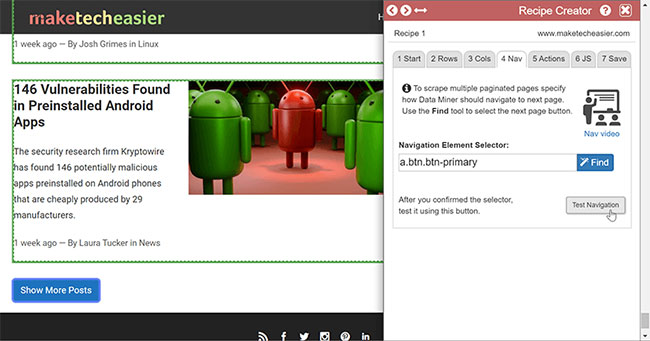
8. Tell the Data Miner where to click or scroll to load the data
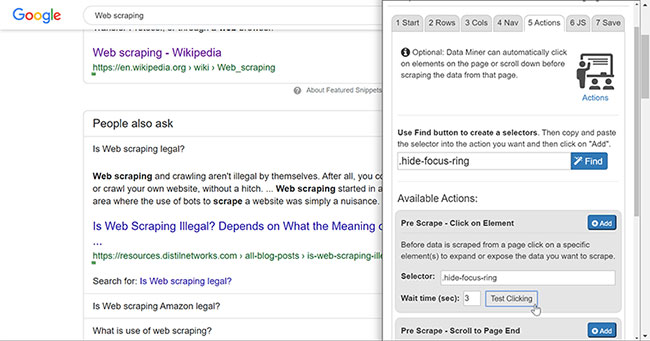
Some pages do not load data until you click on something or scroll down. Fortunately, Data Miner can do these things too! Use the Find tool at the top to select the element you need to manipulate, then place the selector in the appropriate box and check to make sure it works.
Finding out exactly which selector will trigger an element or infinite scroll bar can be difficult, but basic HTML knowledge, as well as some trial and error will be helpful here. Most of the things you'll need to manipulate here are JavaScript based, but the Data Miner only needs to know the CSS selector associated with the action to activate it, so you don't have to mess around with any code. in most cases.
The next step also allows you to add custom JS to do whatever you want, but that's quite advanced and far exceeds what is needed to extract basic data.
9. Save and run the formula
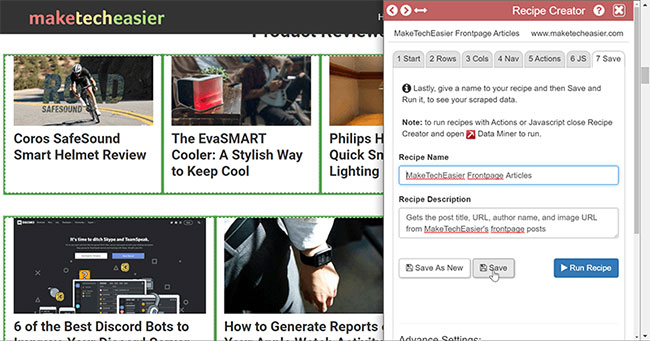
Congratulations! Now it's time to see if all combined properly. Run the formula on the page where you are logged in, then check the preview to see if the rows and columns are doing everything as intended. If not, you can go back and edit the formula.
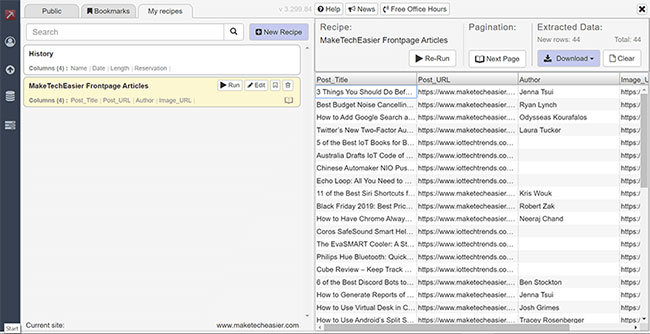
If everything works as usual, you can use the 'Next Page' button to tell the Data Miner how many pages to crawl and how fast it is performing (Doing so quickly can cause the system to flag you. is bot).
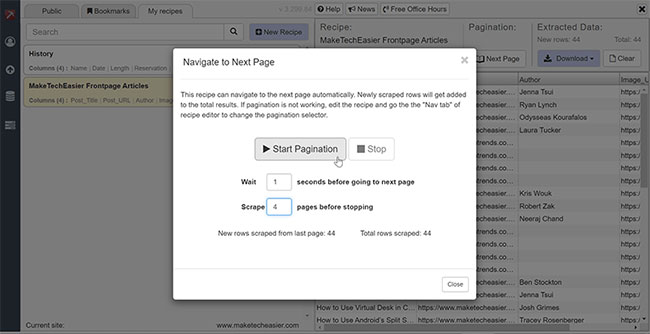
After you have all the data you need, you can choose the file format you want to use for download.
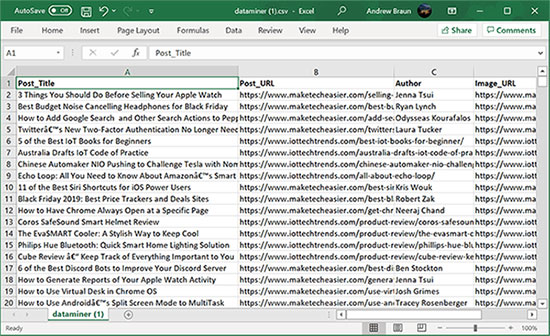
If there is a problem, is there an easier way?
If the Data Miner program is not right for you, there are many other data scraping tools available such as ParseHub, Scraper, Octoparse, Import.io, VisualScraper, etc. Some of these tools may have an online interface. This is a bit more intuitive and automated, but you'll still need to know at least a little bit about HTML and how websites are organized.
What makes Data Miner particularly good for beginners is the library of recipes from the community, capable of helping you avoid even the slightest 'encounter' with the code. That, combined with the generous monthly free scrape package, makes Data Miner a very good tool for almost any need.
Hope you are succesful.
You should read it
- How to remove OSDSoft Trojan DBUpdater.exe Miner
- How to extract numbers or text from Excel
- 10 tips for businesses before deciding to invest in Big Data
- How to import data from photos into Excel
- After Norton, it was Avira's turn to integrate a virtual currency miner into anti-virus software
- Extract Excel content into image format
- What is data leakage?
- How to Extract Fundamental Data on a Bloomberg Terminal
May be interested
- How to extract ZIP file on computer quickly
 how to extract zip file on computer quickly. if you regularly download the data files on the internet to your computer, it is probably no stranger to the zip file format. this is a very common file compression format, compressing the file will ensure t
how to extract zip file on computer quickly. if you regularly download the data files on the internet to your computer, it is probably no stranger to the zip file format. this is a very common file compression format, compressing the file will ensure t - Extract Excel content into image format
 there is a lot of data on excel spreadsheets you want to turn into images for use in word documents or for sharing with everyone. instead of taking pictures of data on excel spreadsheets and editing to get images that contain data content, you can t
there is a lot of data on excel spreadsheets you want to turn into images for use in word documents or for sharing with everyone. instead of taking pictures of data on excel spreadsheets and editing to get images that contain data content, you can t - Antminer S19XP, the 'healthiest' Bitcoin miner on the planet
 antminer s19xp is the world's most powerful bitcoin mining device recently introduced by bitmain - the world's largest manufacturer of cryptocurrency miners.
antminer s19xp is the world's most powerful bitcoin mining device recently introduced by bitmain - the world's largest manufacturer of cryptocurrency miners. - Extract text from images (OCR)
 today, you have a lot of free and effective options when you want to take text out of images instead of re-typing all the content manually. these are the best solutions we have collected so we will show you exactly the results of the documents that are exported from different tools to compare the quality of each method.
today, you have a lot of free and effective options when you want to take text out of images instead of re-typing all the content manually. these are the best solutions we have collected so we will show you exactly the results of the documents that are exported from different tools to compare the quality of each method. - What is ETL? How does ETL work and why use elt?
 etl stands for extract - transform - load, commonly used in big data, mostly in data warehouse.
etl stands for extract - transform - load, commonly used in big data, mostly in data warehouse. - 4 ways to import data from websites into Google Sheets
 if you use google sheets to analyze data then you already know that copying and pasting data from websites is ineffective.
if you use google sheets to analyze data then you already know that copying and pasting data from websites is ineffective. - How to hide the 'Accept Cookies' message from websites
 thanks to the general data protection regulation (gdpr) in may 2018, websites are now not allowed to hide how they store and use user data.
thanks to the general data protection regulation (gdpr) in may 2018, websites are now not allowed to hide how they store and use user data. - How to extract audio from video on Android
 removing audio (audio) from video can be done easily on the computer with specialized software. however, without a computer, you can still do this on android phones quickly thanks to the application called timbre.
removing audio (audio) from video can be done easily on the computer with specialized software. however, without a computer, you can still do this on android phones quickly thanks to the application called timbre. - How to extract multiple files on Windows 10
 application zip open zip all zip tar unrar unzip will extract multiple files simultaneously on windows 10.
application zip open zip all zip tar unrar unzip will extract multiple files simultaneously on windows 10. - 6 best Bitcoin digging software for Windows, Mac, Linux
 if you are planning to dig bitcoin, you cannot ignore these 11 bitcoin mining software. read and choose the right software for you.
if you are planning to dig bitcoin, you cannot ignore these 11 bitcoin mining software. read and choose the right software for you.










 How to use Sharetxt.xyz to share documents directly
How to use Sharetxt.xyz to share documents directly How to turn Kodi into an Arcade game center
How to turn Kodi into an Arcade game center How to save notes as photos with Marked.cc
How to save notes as photos with Marked.cc Download Jotun: Valhalla Edition, a great Norse mythology game, for free
Download Jotun: Valhalla Edition, a great Norse mythology game, for free How to install and use Coc Coc Pro on your phone
How to install and use Coc Coc Pro on your phone How to write a diary on Moodice Windows 10
How to write a diary on Moodice Windows 10